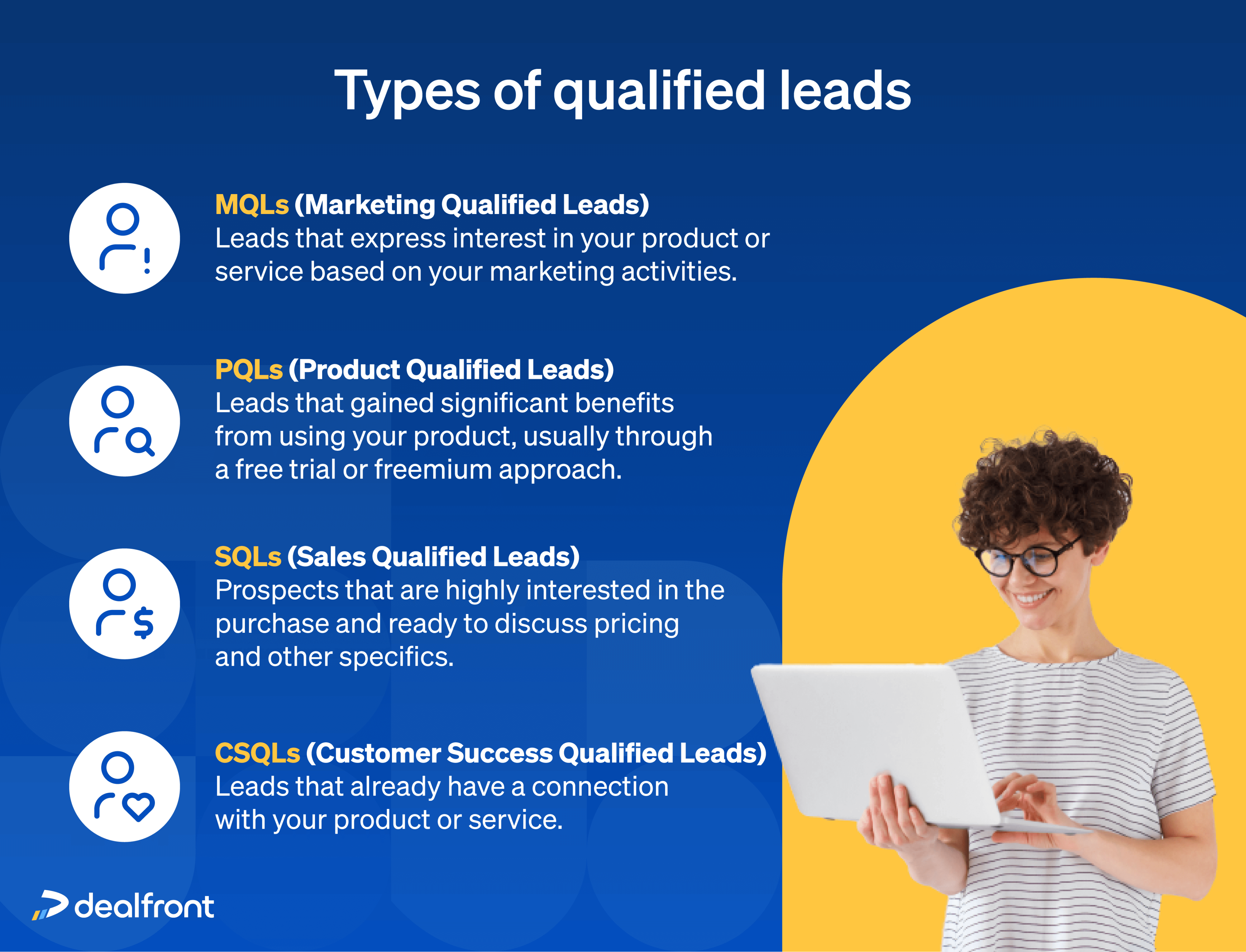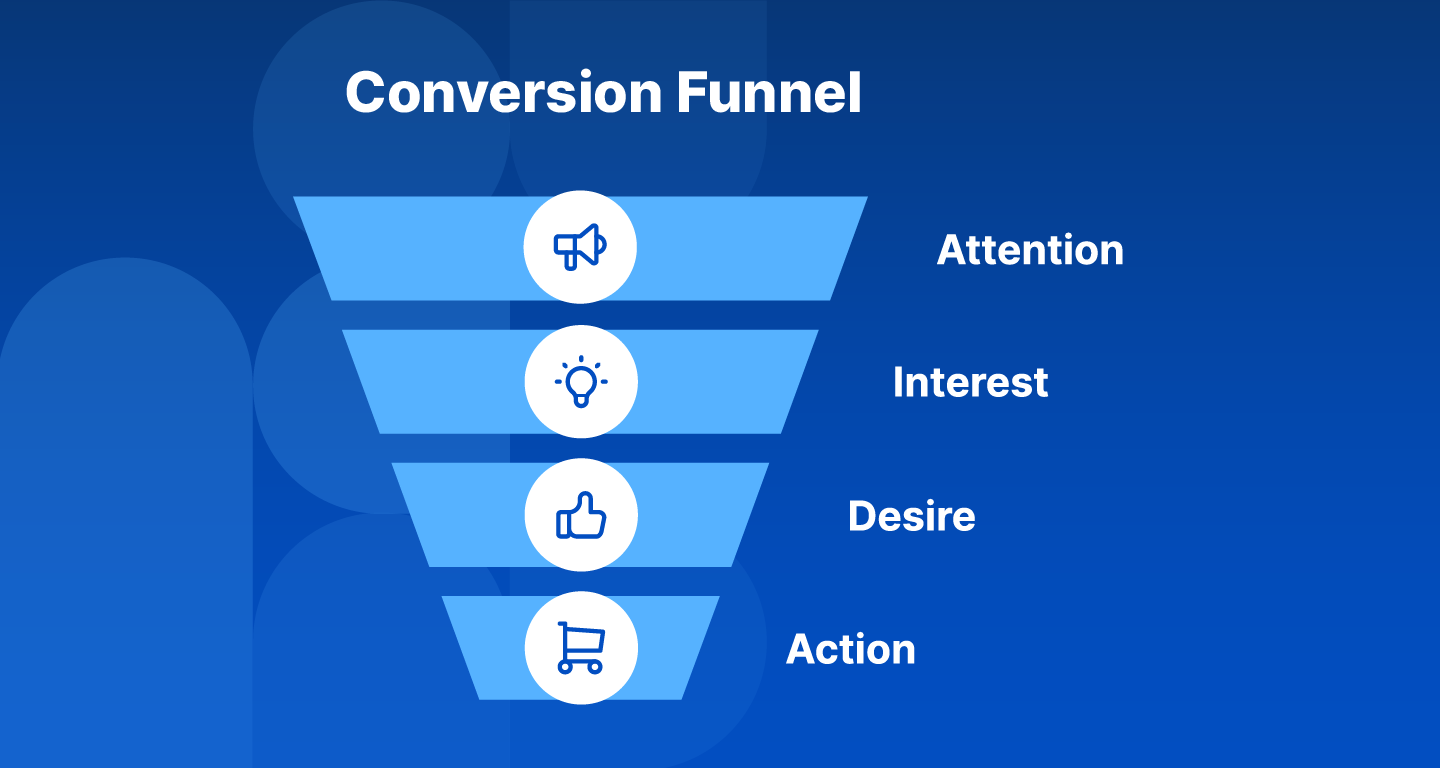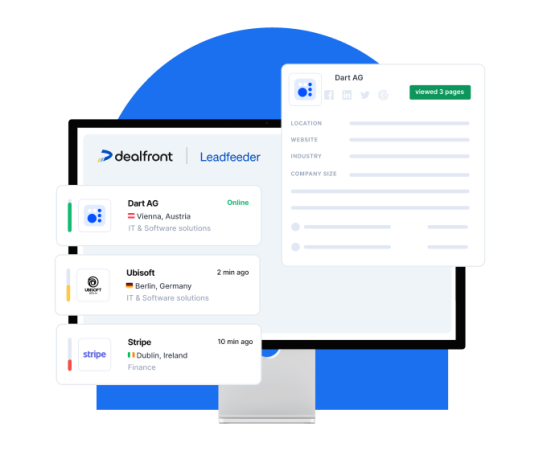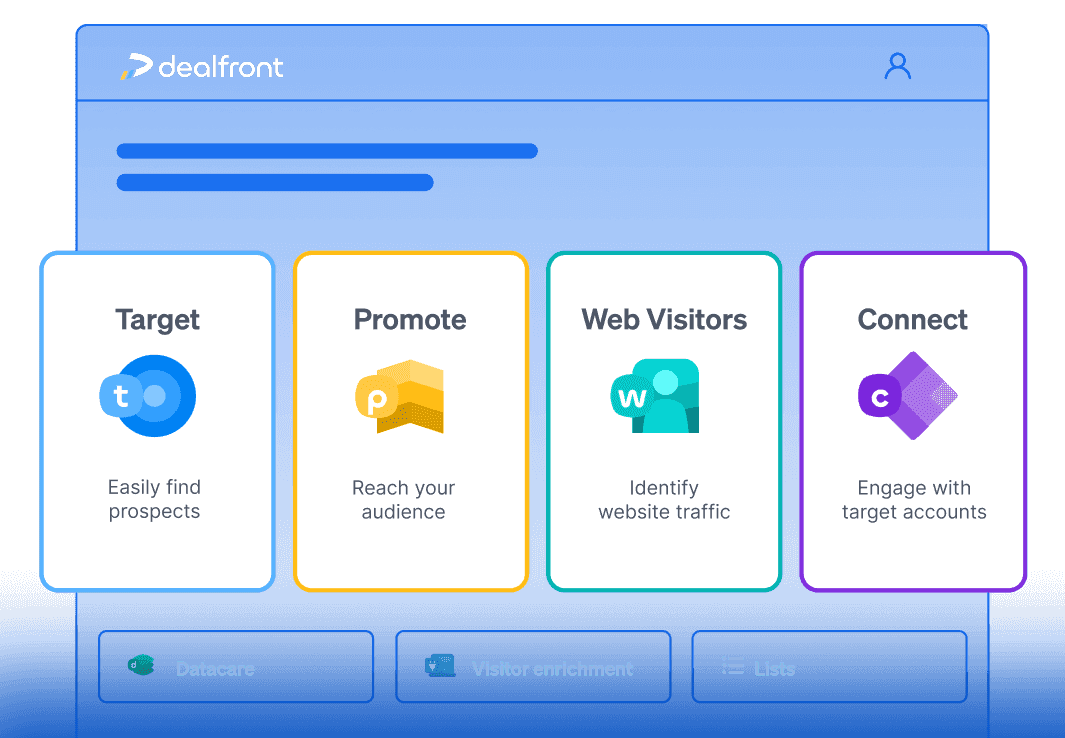Lead generation plays a crucial role in the world of B2B. It’s the process of identifying, attracting, and engaging potential customers (or leads). But many companies fail to establish contact, qualify, and follow up with leads correctly. Without fully leveraging lead generation you’ll end up with low conversion rates and lost revenue opportunities.
To get lead generation right, you need to know what a lead is, how to work with them toward your company's growth, and how to optimize your strategy. Fortunately, this article will tell you everything you need to know about leads, including why and how to generate them for better business results.
What are leads?
A lead is an individual or a business interested in your business offering. Potential leads show readiness to share their contact information with you (email, phone number, or social media) to establish contact and start a relationship.
The goal of any business is to attract these potential leads and convert them from merely interested visitors into loyal clients. Lead generation allows you to do precisely that. This strategy involves creating lead magnets or lead generators to spark interest in leads and engage them to become buyers, whether through organic methods or by strategically opting to buy leads to supplement your efforts.
Lead magnets are typically free assets that help leads in some way. They also aid you in convincing these leads that your products and services are right for them. These assets can include anything from free trial subscriptions to white papers, landing pages, blog posts, and e-newsletters.
Ideally, people will already know about your company, and this process will start out naturally. Warm leads usually come to you, expressing interest in your product or service and requiring only a little nurturing toward becoming customers.
However, there are also cold leads or people who may not know about your company or its offering. These usually require a bit more lead nurturing to become new customers.
But don’t worry, we’ll delve into how to approach lead generation with both warm and cold leads a little later on.
What does lead generation accomplish?
The goal of lead generation is to spark consumer interest with sales and marketing strategies. But generating leads goes beyond acquiring the contact information of a potential customer. It marks the beginning of the relationship between your business and its customers.
This relationship builds upon intentional and careful actions. It aims to develop credibility and trust and enhance the customer experience for the benefit of both you and your leads.
5 benefits of lead generation
A successful lead generation process works to minimize missed opportunities and help land high-quality clients. Once you establish a solid lead gen strategy, you can expect to reap the following benefits:
1) Increased sales opportunities
Lead generation helps generate a continuous stream of potential customers, expanding the sales pipeline. By proactively reaching out to individuals or businesses who have expressed interest in your products or services, you increase the likelihood of converting them into paying customers.
2) Targeted marketing efforts
Through lead generation, you can target specific demographics, industries, or customer profiles that are most likely to be interested in your offerings. By tailoring your marketing efforts towards these targeted leads, you can maximize the effectiveness of your campaigns. It helps you reach the right audience with the right message.
3) Improved ROI (Return on Investment)
The chances of converting warm leads into customers are typically higher than cold leads in any business. Lead generation allows you to focus your marketing efforts on individuals who may eventually pay for your products or services. By investing resources in nurturing and converting these high-quality, warm leads, you can achieve a higher ROI compared to broader, less targeted marketing campaigns.
4) Valuable customer insights
In sales and marketing, data is everything. When generating new leads, you have an opportunity to gather valuable information about your potential customers through opt-in forms. You may also get demographic data from visitors in exchange for lead magnets like free eBooks, courses, or guides.
Lead information, such as contact details, preferences, or pain points, give you insights into customers' needs. You can use all this to tailor your marketing and sales approach accordingly. Consequently, you can build stronger customer relationships, enhance personalization, and address customer concerns effectively.
5) Business growth and expansion
Effective lead generation strategies contribute to the growth and expansion of your business. By consistently attracting and converting leads into customers, you can expand your customer base, increase market share, and strengthen your brand presence.
This growth can lead to further opportunities, such as entering new markets, introducing new products or services, or expanding your business operations. In order to gain a deeper understanding of how business leads work, it is crucial that you read more about them.
Types of lead generation
There are two main ways to find potential customers: inbound and outbound lead generation. Both methods aim to turn interested people into buyers, but they work in different ways and have different results.
Factors like your business setup, budget, and who you're trying to reach can help you decide which method is best.
Inbound lead generation
Inbound lead generation is a strategy where your company encourages a potential customer to take action, such as asking for more information, requesting a demo, or registering for a free trial. With inbound lead generation, a prospect decides to talk to you and initiates the conversation. They willingly provide contact information, often in exchange for an offer or a lead magnet from inbound marketing.
Lead magnets come in many forms but are mostly content that provides valuable information. For example:
eBooks
Guides
White papers
Course
Webinars
Templates
Once visitors request access to a lead magnet, they move a step closer to becoming qualified leads. Since they reach out to you first, inbound leads offer a stronger indication of turning into paying customers.
Inbound lead generation, however, can be slow. You may need to wait a while for your prospects to reach out. A permission marketing strategy, as it relates to inbound lead generation, is very time-consuming because you're waiting for the prospect to reach out.
Outbound lead generation
Outbound lead generation is when your company reaches out to people it thinks would be interested in a product or service. Your sales and marketing teams adopt a strategy to push your message and brand out to prospects. To attract high-quality leads, a company invests in paid campaigns on social media platforms or search engines.
Another way of landing outbound leads is researching specific prospects and directly reaching out to them using various methods, such as:
Cold emails
Display advertisements
Events
Content syndication.
The advantage of outbound lead generation lies in the increased control it provides to the organization. It allows you to carefully select and target the specific audiences or clients you wish to attract and ultimately convert.
However, there is a possibility of encountering new leads who initially don’t show any interest in making a purchase. Such leads require more time and effort to nurture and convert into customers.
Types of qualified leads
Not all leads are the same. Depending on the lead generation strategy, you will always end up with leads who need various levels of convincing to onboard.
MQLs (Marketing Qualified Leads)
An MQL is a lead that expresses interest in your product or service based on your marketing activities. MQLs usually interact with content released within your marketing campaigns and often intentionally engage with your brand. They are typically promising leads who are already considering your offers.
B2B marketers classify a lead as an MQL depending on various factors, including the web pages they visited, the content offers they downloaded, the CTA (call to action) they clicked on, and their interactions with social media posts.
PQLs (Product Qualified Leads)
A PQL is a lead who has gained significant benefits from using your product, usually through a free trial or freemium approach. PQLs are highly likely to become customers compared to other leads because they already know how your offers function. There's usually no need to convince them about your product's value.
SQLs (Sales Qualified Leads)
An SQL refers to a prospect highly interested in the purchase and ready to discuss pricing and other specifics. The sales team designates an SQL as ready to become a paying customer.
SQLs have moved from being an MQL and may have progressed from a PQL. The sales team evaluates the lead to gauge their level of interest, intent, and fit with the organization's product or service offering. This comprehensive assessment determines the prospect's readiness to buy the product or service. It typically involves direct communication, such as phone calls, meetings, or email exchanges.
Every company will have different criteria for assessing SQLs. However, all will aim to qualify the lead according to their specific needs, pain points, and purchasing time frame.
CSQLs (Customer Success Qualified Leads)
A CSQL is a lead that already has a connection with your product or service. They are more likely to upsell, cross-sell or refer other leads to you. Such a lead has a high potential to be a successful long-term client as they come from your existing customer base or referrals.

What type of lead generation is right for your business?
Choosing which B2B lead generation method to use can be complicated. To start, focus on the strategy that works best for your business type.
Product-led SaaS companies
If your company is product-led, inbound lead generation is the go-to approach. In this model, product qualified leads (PQLs) are a critical part of product-led motions. PQLs are leads that have shown they are likely to find value from your solution. Usually this means they've signed up for a product demo and have demonstrated a high level of engagement.
Sales-led SaaS companies
In a sales-driven company, outbound lead generation may be the best option. The sales and marketing teams in sales-led companies are constantly reaching out to potential customers in unfamiliar markets. So they need smarter and more aggressive tactics than would be required in an environment where prospects are already aware of brands and their offerings.
The lead generation funnel
A lead generation funnel represents how a prospect moves from being a lead to a paying customer.

Let's explore the different stages of the sales funnel and what they entail.
TOFU (Top of the funnel): Awareness
In this initial stage, the focus is on raising product or brand awareness. Through marketing initiatives like SEO (search engine optimization), content marketing, social media marketing, email marketing, and paid advertising, you aim to get people to notice you.
The goal is to generate interest by providing relevant content that caters to people's needs. It is also at this stage that you create a database containing all the relevant information about your lead. It will help you to personalize your approach moving forward.
MOFU (Middle of the funnel): Interest
Once you capture the attention of potential customers, the next step is to get the lead thinking about your product as a solution to their problem. The goal of this step is to make a lead want to take action. You want them to decide to try your product. It's the only way they will know for sure it will meet their needs.
Some leads may not be ready to make a purchase immediately. Don’t give up on them just yet. Continue engaging with them, providing information and assistance. These leads might become interested soon, so nurturing their interest should not be overlooked.
BOFU (Bottom of the funnel): Action
Once your lead has decided to take action, they will proceed to make a purchase. You can utilize smart strategies to entice a lead to buy your product or service. For example, you may decide to offer discounts or coupon codes.
After paying for your product or service, your lead becomes a customer and reaches the end of the lead gen funnel. However, the customer journey doesn't end when your leads become customers. To retain your hard-earned customers, ensure you engage and cultivate relationships with them.
The lead generation process
If you're unsure how to start generating quality leads, here's a step-by-step guide to help you out.
Step 1: Establish your ICP
An ICP (ideal customer profile) defines the perfect customer for your company. That is, ICP describes a fictional company that would benefit the most from your product or solution. Such a company usually buys quickly, maintains successful sales, and keeps using your product for a long time.
Once you familiarize yourself with your ideal customer profile, you can find the best opportunities among the many organizations that visit your website. To do this, learn as much as possible about your current customers. Determine what similarities they share and make a list based on what you find out.
For example, consider the following factors:
How much your customers spend over time
How long do your customers stay with your company
How quickly do your leads start using your product
The size and location of your customer's business
How many employees do your customers have
Once you have this information, use it to create two or three ideal customer profiles.
Step 2: Create content for your ICP
Once you have your ideal customer profile(s), you can start developing content to capture the interest of your primary target audience. First and foremost, ensure you compose captivating, relevant, and accurate content that provides value to your leads.
Then, create a content calendar to organize and keep track of the distribution of your content. You should also carefully select the platform to share your content. If, for instance, your ICP is active on LinkedIn, personalize your content for that specific platform.
Don’t use the same content for every audience group. Customize it to fit each of your ideal customer profiles. Include visual content such as educational videos, interactive infographics, and summarized illustrations to explain complex ideas engagingly. Remember to use compelling calls to action to guide your ideal customer smoothly to the next stage of the funnel.
Step 3: Utilize a lead intelligence platform
Instead of doing everything alone, consider partnering with a lead generation expert to streamline your lead generation. As the leading go-to-market platform in Europe, Dealfront is currently helping more than 10,000 companies win at generating the right leads for their businesses.
With Dealfront, you can use various tools to speed up your lead generation efforts and boost conversion rates. Target, for instance, is a B2B sales database that gives you access to more than 30 million companies, 89 million contacts, and 500 data attributes. With this information, you can create lead lists and drill down to your ideal ICP using more than 100 filters, trigger events, company news, and financial data.
With Target, it doesn’t matter what industry you’re in. You can boost your prospecting, market analysis, and B2B lead generation.
Leadfeeder, on the other hand, helps you understand and engage with the B2B companies visiting your website in real-time. The tool allows you to track the behavior and interests of your website visits and send that data to your sales team. With this valuable information, the sales team can better target leads and convert them to customers more efficiently.
Step 4: Prioritize sales and marketing alignment around the lead gen funnel
Sales and marketing alignment is crucial for the lead generation funnel as it enables a seamless transition for potential customers from the top to the bottom of the funnel. With cohesive teamwork, both teams create a consistent messaging strategy that supports the lead's journey.
As we talked about before, your aim is to make leads aware of your brand with your content with a broader reach. Then, get them interested in your product with offers they'll most likely be interested in.
Step 5: Work smarter, not harder
Use lead generation tools to automate manual, time-consuming tasks. Lead gen automation software, such as HubSpot and Outfunnel, has various marketing automation tools to streamline your operations.
The core areas in which sales automation tools can help are:
Lead generation
Lead management
Scheduling
Data entry
Research
Metrics analysis
Reporting
Tracking.
Once they automate their work, sales reps can receive reminders about which potential customers are prepared to take the next step in their purchasing process. They can concentrate on these more promising contacts while knowing new prospects are being discovered, nurtured, and interacted with.
Automation is a smart move. It enables your sales department to excel at their work while ensuring that new leads continue to progress through the sales funnel.
Step 6: Analyze and make adjustments for ultimate lead scoring
It is essential to track KPIs (key performance indicators) at each step of the lead generation journey. However, reporting is critical once you hand the leads to the sales team. Pay attention to the buyer journey to improve your strategy over time.
If your funnel loses momentum at any stage, take the time to review and assess the situation. Use the data collected and analyze it to make necessary changes. Identify the lost leads and consider retargeting ads, promotions, and discounts to win them back.
You should perform analysis and planning before and after the lead generation process. Although this step may seem simple, don’t overlook or rush it. It allows you to learn from the previous cycle and get ready for the next one.
If you strive to outperform competitive point solutions, leverage a strong combination of data with integrated and collaborative applications. Datacare is a cutting-edge data management tool that can help you check, cleanse, enrich, and optimize your data. With its advanced features, Datacare ensures that you can maintain and improve the quality of your data any time you want.
Audi’s successful lead generation campaign
Big names in different industries have already used lead generation to their advantage. During the launch of the Audi A8 in the Middle East, Audi couldn’t rely on consumer data from buyers in European markets. The company knew its ICP was younger than in any European country.
Audi worked with LinkedIn to develop a strategy targeting government-related industries where their ICP was most likely to be working. The campaign engaged more than 300,000 viewers with a 30-second video showcasing the A8’s luxury features. Sponsored InMail then delivered a personalized introduction to the A8, which saw an open rate of 66% and a click-through rate of 5.7%.
As you can see, Audi’s lead gen campaign delivered on both awareness and the number of leads generated. With a substantial number of potential customers in its pipeline, the company was able to penetrate the Middle East market.
Choose a digital marketing solution that works for you
That was a lot to take in, we know. But now you’re equipped with the knowledge on what lead generation is, the different methods to generate leads, and how to establish a sustainable process.
However, being equipped with the knowledge so you can lay the groundwork for successful lead generation is just the start. A continuous stream of high-quality leads is every company's target. But as all companies differ, so do their lead generation methods.
Since different strategies offer different results, don’t be afraid to experiment until you find the method that works best for your business!








